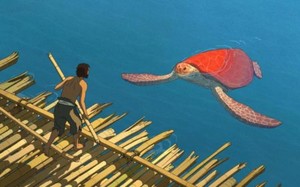Review
by Theron Martin,The Red Turtle
| Synopsis: |  |
||
In stormy seas, a shipwrecked man is cast onto a remote tropical island. He finds himself alone and occasionally experiencing delusions, so he sets about building a raft to leave the island. But something – or perhaps someone – doesn't want him to leave, as his rafting efforts keep getting thwarted by what he eventually discovers is a red turtle. There's an awful lot more to this turtle than initially meets the eye, and he may well have found a companion for a lifetime. |
|||
| Review: | |||
Calling the 2016 Academy Award nominee The Red Turtle a true anime movie may be dubious, since it's a co-production between Studio Ghibli and the French studio Wild Bunch, directed by Dutch-British animator Michael Dudok de Wit, who won the 2000 Academy Award for best animated short. On top of that, the bulk of the staff isn't Japanese. However, it does have Ghibli luminaries Toshio Suzuki and Isao Takahata listed in the credits as a producer and artistic producer respectively, so Ghibli's prominent involvement is enough to warrant attention from the anime fan base. Nevertheless, you shouldn't go into this film expecting it to look like a traditional Ghibli project – or even many anime at all, for that matter. The fairly simple character designs, which feature only black dots for eyes, show a more decidedly Western design influence. Background and setting designs aren't lavish either, but whether bamboo forests or a pool in a crevice, they are still rich enough in detail that they seem reminiscent of real locations. The color scheme is uniformly drab, but that's fitting, as vivid coloring would have been deeply out of place in this story. The real treat is the smooth animation effort, which results in some truly remarkable scenes in both slower and grander moments; one scene involving a tsunami is a stand-out, but the movie speaks volumes with simpler things like body language. The film's ability to communicate through action and body language is particularly important, as this is a movie essentially without dialogue. The main character does shout a few times – either “hey!” or a cry of frustration – but he otherwise communicates entirely through movement. Of the two other characters who eventually appear, one never utters a sound and the other only does some shouting and laughing. However, nothing ever feels like it's missing for the lack of dialogue. These characters don't need names, and nothing really needs to be said in most cases. Call this an exercise in minimalism if you like, or perhaps an object lesson in how needlessly verbose human communication can sometimes be. Complementing this is a fully orchestrated musical score, which delivers a consistent light touch except for a couple of more tense scenes. The story is much more basic. Taken at face value, it could be looked at as a variation on Robinson Crusoe, but it doesn't spend much time at all on the minutiae of how the protagonist learns to survive on the island. It just assumes that food is readily available enough and the protagonist has at least rudimentary knowledge on how to take advantage of his surroundings. There's a vague implication that he eventually figures out how to make his own clothes from the carcass of a seal, but given that his clothes look exactly like the ones he started out with years later, the story is clearly ignoring most petty concrete details. The focus is much more on the broader picture of how he comes to accept life on the island and how time flows both for him and the turtle over the long haul. It is poignant and, at times, heartbreaking, despite few scenes depicting intense danger. It's also as complete as such a story can be, with the actions of the island's crabs seeming to suggest that things will run their natural course. At this time, the movie is only available for purchase or rental via iTunes. [EDIT: It is also apparently available in hard copy form, but the iTunes release was used for the review.] Its purchase does come with substantial extras, including a full commentary track with the director, 74 minutes of behind-the-scenes footage, and a 21-minute Q&A session from the AFI Fest. It can be downloaded in 720p, streamed in 1080p, and has Portuguese, Spanish, and English subtitles available. Its only spoken language is technically English, but since there's essentially no dialogue, dubbing isn't really a factor here. The Red Turtle was picked over your name. for the Academy Award nomination. I can definitely see why it was selected, as it is a very well-crafted movie likely to appeal more to the Oscars crowd, and it has already been nominated for or won a number of critics' awards. But whether it's a better movie will definitely come down to personal taste. While The Red Turtle definitely has its own appeal and both are quality productions, your name. was more compelling and emotional for me; I would be more likely to watch it again than The Red Turtle. |
| Grade: | |||
|
Overall (dub) : A-
Story : A-
Animation : A
Art : A-
Music : A-
+ Exquisite use of action and body language largely negates the need for dialogue, great animation |
|||
|
discuss this in the forum (14 posts) |
this article has been modified since it was originally posted; see change history |
|||